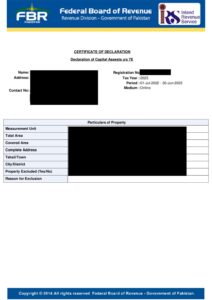1. Normal Tax Year (NTY):
- Definition: NTY is the standard tax year structure, lasting for 12 months. However, it's important to note that it is Denoted by Calendar Year in which NTY ends.
- Example: A tax year ending on 30th June is an NTY.
2. Transitional Tax Year (TTY):
Denoted by Calendar Year relevant to NTY in which Year end falls:
- TTY occurs due to a change in TY from NTY to Special Tax Year (STY) or vice versa.
- It is the period between the TY end date of the last tax year and the commencement date of the next TY.
3. Special Tax Year (STY):
- Denoted by Calendar Year in which NTY ends:
- STY is relevant to NTY in which the year end falls.
- FBR has authority to prescribe STY:
- The Federal Board of Revenue (FBR) has the authority to prescribe STY.
![Understanding Tax Years and Their Categories [S-74]](https://taxpills.com/wp-content/uploads/2024/02/3ce1f43a-2a61-48a6-ba85-bb9e2b437193.jpg)
4. Industry Special Tax Year:
- Definition: Certain industries may follow a tax year structure different from the standard NTY or STY. This is referred to as Industry Special Tax Year.
- Examples:
- Sugar Manufacturing: Runs from 1st October to 30th September. (Reference: SRO 134(R)/68, July 31, 1968)
- Rice Exporter: Follows a calendar year, from 1st January to 31st December. (Reference: SRO 367(I)/74, January 14, 1974)
- Insurance: Operates from 1st January to 31st December. (Reference: SRO 878(I)/95, August 30, 1995)
How Understanding Tax Years Helps:
- Compliance: Understanding these tax year structures is crucial for individuals and businesses to comply with tax regulations.
- Reporting: Proper reporting aligns with the specified tax year, ensuring accurate financial statements and tax filings.
- Planning: Knowledge of different tax year structures helps in strategic financial planning.
Conclusion:
- By providing clear explanations and examples related to tax years, students and individuals can gain a solid understanding of these concepts. Crafting content that educates and simplifies complex topics is key to ranking well on search engines like Google.
For Further Assistance or Consultation, Please Feel Free to Contact Us:
Tax Year Practice
Determine the tax year in respect of each accounting periods mentioned below:
| Period | Year | Tax Year |
| a) 1.09.2015 to 31.08.2016 | STY | TY 2017 |
| b) 01.04.2016 to 30.06.2016 | TTY | TY 2016 |
| c) 1.01.2016 to 31.12.2016 | STY | TY 2017 |
| d) 1.04.2016 to 31.03.2017 | STY | TY 2017 |
| e) 1.05.2016 to 30.04.2017 | STY | TY 2017 |
| f) 1.07.2016 to 30.06.2017 | NTY | TY 2017 |
Change in Tax Year Procedure
From NTY to STY:
- Tax Payer's Application:
- The Tax Payer submits a written application to the Commissioner of Income Tax (CIT) expressing the intent to change from NTY to STY.
- CIT's Evaluation:
- The CIT assesses the application and determines whether there is a compelling need for the change.
- Compelling Need Convinced:
- If the CIT is convinced that a compelling need exists, the application proceeds to the next steps.
- Compelling Need Not Convinced:
- If the CIT is not convinced, the Tax Payer is given an opportunity to be heard in person.
- Opportunity for Hearing:
- The Tax Payer presents their case in person to address any concerns or questions raised by the CIT.
- CIT's Decision:
- If the CIT remains unconvinced even after the hearing, two actions can be taken:
- Issue rejection orders.
- Record reasons for rejection in an order.
- If the CIT remains unconvinced even after the hearing, two actions can be taken:
- Review Application to FBR:
- In case of rejection, the Tax Payer has the option to file a review application to the Federal Board of Revenue (FBR).
- FBR Decision:
- The FBR reviews the application and its decision is deemed final.
From STY to NTY:
- Tax Payer's Application:
- Similar to the transition from NTY to STY, the Tax Payer submits a written application to the CIT expressing the intent to change from STY to NTY.
- CIT's Evaluation:
- The CIT assesses the application and determines whether there is a compelling need for the change.
- Compelling Need Convinced:
- If the CIT is convinced that a compelling need exists, the application proceeds to the next steps.
- Compelling Need Not Convinced:
- If the CIT is not convinced, the Tax Payer is given an opportunity to be heard in person.
- Opportunity for Hearing:
- The Tax Payer presents their case in person to address any concerns or questions raised by the CIT.
- CIT's Decision:
- If the CIT remains unconvinced even after the hearing, two actions can be taken:
- Issue rejection orders.
- Record reasons for rejection in an order.
- If the CIT remains unconvinced even after the hearing, two actions can be taken:
- Review Application to FBR:
- In case of rejection, the Tax Payer has the option to file a review application to the Federal Board of Revenue (FBR).
- FBR Decision:
- The FBR reviews the application, and its decision is deemed final.
If you wish to read Section 74, search for a post related to the Income Tax Ordinance in the Tax Year 2024 category. Check if the Income Tax Ordinance is provided or linked in that post, and then download it for reading.

Frequently Asked Questions (FAQs) and Their Answers
- What is a Normal Tax Year (NTY) and how does it impact my business?
- Answer: NTY is the standard 12-month tax year structure. It's crucial for businesses to align their financial planning and reporting with this period for compliance.
- How does a Transitional Tax Year (TTY) affect my tax filings?
- Answer: TTY occurs during a change in tax year structure. Understanding its implications is key for accurate financial statements and tax filings.
- What is a Special Tax Year (STY) and when might a business opt for it?
- Answer: STY is an alternative to NTY, prescribed by the Federal Board of Revenue. Explore when and why businesses might choose this structure.
- Can you explain the concept of Industry Special Tax Year with examples?
- Answer: Industries like Sugar Manufacturing, Rice Export, and Insurance often have unique tax year structures. Learn how they differ and why.
- How can businesses transition from NTY to STY or vice versa?
- Answer: Detailed steps involved in changing tax year structures, including the application process and review by the Federal Board of Revenue.
- Why is understanding tax years important for financial planning and compliance?
- Answer: Insight into different tax year structures aids businesses in strategic financial planning, compliance with regulations, and accurate reporting.
- What is the role of a Tax Consultant in assisting businesses with tax year transitions?
- Answer: Discuss the valuable assistance a tax consultant can provide during the transition process, including evaluating the need for change and dealing with authorities.
How Can I Help You?
- Return Filing Services:
- Whether you need assistance with individual or business returns, I’ve got you covered. Your returns will be prepared professionally and in accordance with Income Tax rules.
- Customized Solutions:
- Have specific requirements or unique situations? Let’s discuss your needs, and I’ll tailor my services to meet your individual circumstances.
- YouTube Description:
- Find my number in the YouTube description and drop me a message. I’ll get back to you as soon as I’m available.
- Website:
- Visit my website and give me a call or leave a message. I’ll respond promptly to address your queries.
- WhatsApp:
- Prefer WhatsApp? Feel free to send me a message, and I’ll assist you as soon as I’m available.
Professional and Rule-Compliant Services: Rest assured that the services provided will be professional and adhere to Income Tax rules. Your peace of mind is my priority, and I’m committed to offering you the best solutions.
Feel free to reach out whenever you have questions or require assistance with your income tax matters. Looking forward to helping you navigate the world of taxation seamlessly! JazakAllah!


![Understanding Income Tax Filing Obligations: A Comprehensive Guide Sec [114]](https://taxpills.com/wp-content/uploads/2024/02/LimeWire-AI-Studio-Asset-15-1.jpg)










